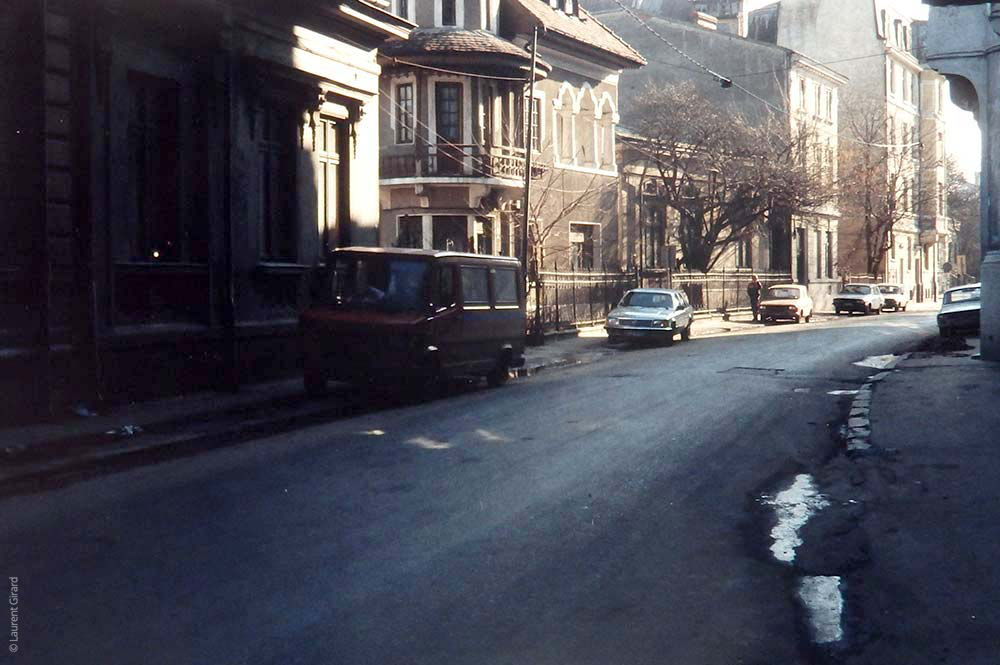Bucarest, janvier 1991. La rue Dionisie Lupu est dans le prolongement de la rue Tudor Arghezi, photographiée le même jour.
La maison au centre de l’image, s’inspire du style Brâncovenesc, ce style architectural typiquement roumain de la fin du XVII au début du XVIIIe siècle.
Elle fut probablement construite entre les deux guerres, une période faste pour l’architecture Roumaine. Le pays se rapprochait de l’Occident, en adoptait les styles, les manières et les règles, tout en laissant derrière elle le souvenir des occupations russe et ottomane.
Dionisie Lupu (né en 1769) qui donne son nom à la rue fut métropolite orthodoxe de Bucarest. Il n’est pas facile de trouver des informations concernant cet homme, dont la date de décès n’est même pas confirmée.
Il joua un rôle de protecteur pour Gheorghe Lazăr, figure de la renaissance culturelle roumaine du début du XIXe siècle.
D. Lupu est mentionné dans un film historique de 1963, Tudor, réalisé par Lucian Bratu par ailleurs visible en ligne.
Pour plus de précisions, voir aussi les commentaires, sous l’article…
Pour aller plus loin...
A propos de l’architecture roumaine du XXe siècle, un article (en français) sur Radio România International.
à la page Facebook
Abonaţi-vă
la pagină Facebook


Salve Girard,
After some painstaking psychogeography invocation I have managed to locate the photo: [Str. Dionisie Lupu nr.64] – it’s the continuation of Str. Tudor Arghezi (at the point where they meet there is a street intersecting that goes into Magheru boulevard).
Here is a progression of 4 current views of Dionisie Lupu in order to better encompass and make sense of the buildings:
1) https://goo.gl/maps/KotdrbbPbmy3wMAA8 (nr.64) – as you can see the street’s wideness is similar to Str. Tudor Arghezi, no more that 9-10 metres, that was an important clue in locating it, both of them are of course one-way streets. Unfortunately more cars are blocking the sidewalk than in 1991 but at least we still have the some of trees and vegetation.
2) https://goo.gl/maps/PS3h8gsqnHwHfoo86 (nr.49) – the house on the left is a sublime example of Neoromanian style, you can better make out the characteristics in your photo: the stretched out round balcony roughly resembling a « bovindou », the arched columns with different motifs similar to the « cule » pattern, the panel woodwork on the balcony definitely has Neromanian influences. In the Google Maps view there is a yellow sign on the house stating that it is for sale and from what I researched it was based on a forced execution of real estate, you can see more photos of the house on the executioner’s site where it was up for sale and apparently sold for 400.000 EUR, the house is famous for its 2 elephants on each side of the entrance way (photo 8, I’m afraid we don’t know their story and how they ended up decorating the entrance) and you can better make out the buildings by looking at the bird’s eye view of the area (photo 10): https://www.executari.com/licitatie-137380-vila-gradina-icoanei-9-camere-teren-295-mp-sector-1.html
3) https://goo.gl/maps/d4hkLo8ETGLxtbhYA (nr.56) – as you can see, the most probably Neoromanian style house (the person in your photo walks right in fron of it) was demolished I think in recent years and a new 4 storey building was built upon its site. This trend of demolishing these architectural beauties is quite common in this area (Streets Dionisie Lupu, Arthur Verona, Polona), the unscrupulous and tasteless real estate sharks take full advantage thinking only of their pockets and leaving open wounds on this city’s architectural memory.
4) https://goo.gl/maps/3vgEbJjbrfCwsFa37 (nr.52) – this is the last building where the street ends in your photo and intersects Str. Arthur Verona.
The Str. Tudor Arghezi and Str. Dionisie Lupu must have been taken in the same day minutes apart in January 1991. The light and atmosphere are similar <3
A bientôt!
Cordially,
Adrian
Dionisie Lupu was a Romanian orthodox metropolitan bishop who fought for national emancipation at the beginning of the 19th century and was among others the mentor of Gheorghe Lazar (father of the first national Romanian language based school) and member of the welcoming party that greeted Tudor Vladimirescu’s entry in Bucharest during the early stages of the Wallachian uprising of 1821 social and political rebellion against the Ottoman Empire. The second wave of the fight for national unity and independence in the 19th century was of course in Rosetti’s time during the revolution of 1848 lead by the pașoptist group. [the number 48, when it refers to the revolutions of 1848, is pronounced pașopt, which also gave words like pașoptist (meaning « participant in the Romanian 1848 Revolution » or « supporter of its ideology »)].